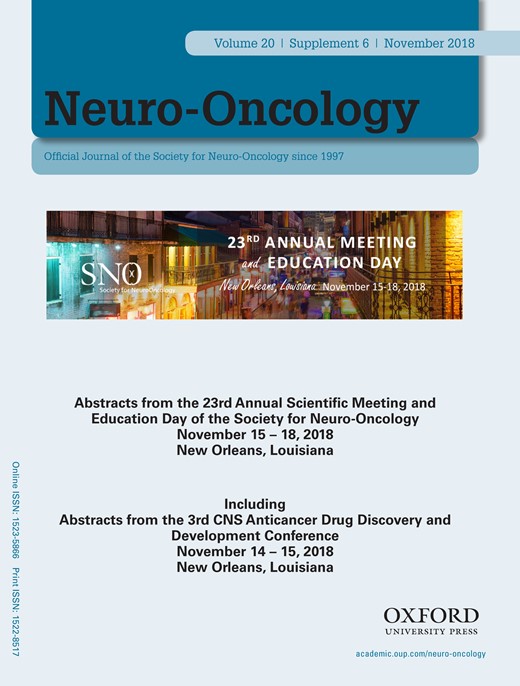-
PDF
- Split View
-
Views
-
Cite
Cite
Terri Armstrong, Ying Yuan, Jimin Wu, Tito Mendoza, Elizabeth Vera, Antonio Omuro, Frank Lieberman, H Robins, Elizabeth Gerstner, Jing Wu, Patrick Wen, Tom Mikkelsen, Kenneth Aldape, Mark Gilbert, RARE-24. OBJECTIVE RESPONSE AND CLINICAL BENEFIT IN RECURRENT EPENDYMOMA IN ADULTS: FINAL REPORT OF CERN 08-02: A PHASE II STUDY OF DOSE-DENSE TEMOZOLOMIDE AND LAPATINIB, Neuro-Oncology, Volume 20, Issue suppl_6, November 2018, Page vi241, https://doi.org/10.1093/neuonc/noy148.998
Close - Share Icon Share
Abstract
Ependymoma is a rare tumor for which the role of chemotherapy has not been established either for newly diagnosed or recurrent disease. We report on the first prospective adult clinical trial of chemotherapy for recurrent ependymoma.
Adult (> 18 years) were treated with dose-dense temozolomide (125–150 mg/m2, 7days on/7days off) and daily lapatinib (1250 mg/day). Efficacy was based on serial imaging of either brain or spine using MRI. Clinical benefit was evaluated using longitudinal assessment of symptom burden (MDASI-BT/MDASI-Spine) and performance status. Primary endpoint was progression free survival. Additional endpoints included 12-month PFS rate, objective response and clinical benefit (KPS and changes in proportion of moderate-severe disease-related symptom burden through cycle 6).
50 patients were treated with this regimen. Median age = 43.5, median KPS = 90, median number of prior relapse = 2. By tumor grade: III n = 19, II n = 16, I n = 8. 25 patients had spinal cord, 15 had supratentorial and 8 had infratentorial tumors. Treatment was well tolerated with a 10% Grade 3–4 myelotoxicity rate. Median PFS = 0.65 years (95%CI 0.46, 1.02). 1-year PFS=38%, with 1 complete and 4 partial responses. KPS improved in all but 1 patient and MDASI measures were completed on 86% of cases with reduction in moderate-severe pain in 53% and 71% of brain and spine patients respectively. Patients with spine tumors reported improvement in numbness (57%), weakness (24%), fatigue (23%)and autonomic dysfunction (bladder control (73%), sexual function (9%), and bowel function (36%)). CONCLUSIONS: These results demonstrate evidence of clinical activity, including objective responses and a nearly 40% stable disease rate at one year, with improvement in disease-related symptoms. This combination regimen was well tolerated and should be considered as a standard salvage regimen for adult patients with recurrent ependymoma.
- magnetic resonance imaging
- chemotherapy regimen
- defecation
- ependymoma
- fatigue
- adult
- asthenia
- objective (goal)
- hypesthesia
- infratentorial neoplasms
- karnofsky performance status
- pain
- brain
- diagnostic imaging
- morbidity
- neoplasms
- spinal cord
- spine
- sexual function
- temozolomide
- bladder control
- autonomic dysfunction
- lapatinib
- surrogate endpoints
- partial response
- neoplasm grading
- progression-free survival




